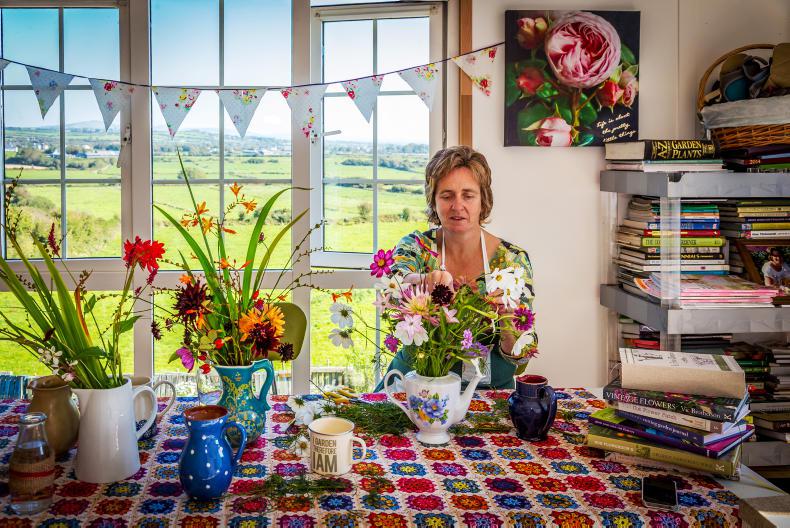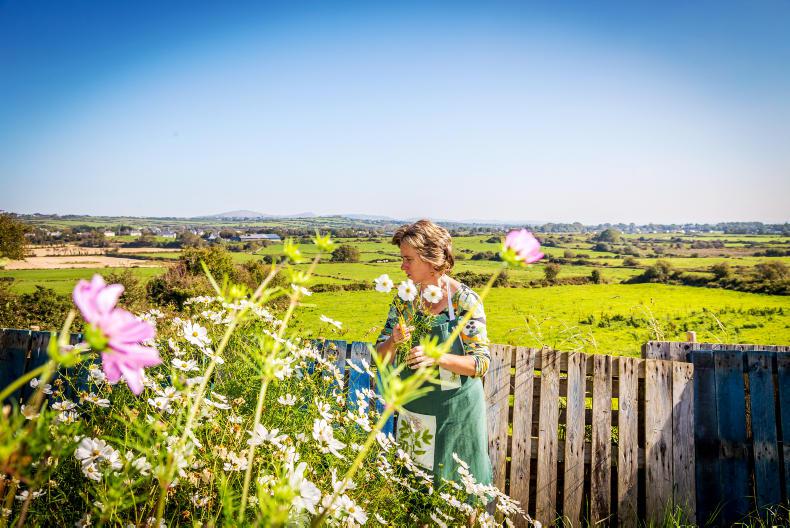If you are new to gardening, why not consider raised beds? Rather than digging out the grass, you can cover the entire area with cardboard and build a raised bed on it, giving you a head start with half the work.
I would suggest a small plot to begin with, such as 3ft×6ft. Figure out the area in your garden that gets the most sun.
If you feel that wind may be an issue, this problem is easy to overcome with wind barriers such as recycled palettes.
You will also need a water source near the patch.
As an organic gardener, I tend to recycle when possible, so I use old scaffolding boards for my raised beds.
However, you can buy high-grade pressure-treated timber or, indeed, a raised bed kit in your local garden centre.

The height of the board varies between six to 10 inches. Some people treat timber with flax oil. This protects the timber as it is water repellent and also seemingly deters slugs.
The final ingredient is some topsoil. Ideally, soil needs to be soft, light and airy so that roots can easily access the necessary nutrition.
If you feel your soil quality is poor, you can buy in some screened topsoil and/or add some good-quality compost to the bed.
Remove any large rocks as they can be obstacles for young roots. Do not overfill the beds with soil; fill to about three-quarters full.
Try the knuckle test: you should be able to sink your finger into the soil right up to your knuckle.
When starting a garden, it helps to choose varieties of flowers that will keep giving all summer long.
Many of the annuals listed here are known as “cut and come again”.
The more you cut, the more they grow and they will thrive with just a little care and attention.
Some of my favourites include cosmos, cornflower, nigella, ammi majus, sweet pea, antirrihinium (also known as snapdragon), straw flowers, calendula (best known as marigold), poppies and larkspur.

3 Don’t be afraid to give yourself a head start
There are a few different ways to approach growing flowers for a cutting garden.
You can sow the seeds directly in the growing area, you can sow your seeds in trays and transplant later into the plot, or you can buy young plants that are ready to transplant.
I would suggest that the easiest option would be to drop into your local garden centre and pick up a few trays of your chosen annuals to fast-track your rate to success.
Gardening can be daunting at the beginning, so do not feel like you are cheating by buying young plants.
Build up your confidence this season and you can always decide to sow your own seeds next time.

A tray of annuals will cost about €3. You will have a manageable number of healthy strong plants, which is a great place to start.
Many people sow too many seeds at the beginning and find they have too many plants.
Every garden book I ever read encourages people to start small, and it’s the best advice I could give.
4 Make your own organic feed
Liquid feeds provide plants with nutrients in a readily-available form.
Organic principles are all about feeding the soil, not specifically the plant, but there are times when a plant needs a tonic.
If you fancy making your own, nettle tea makes a fantastic “pick-me-up” general-purpose feed. You will need:
A decent pair of strong gloves and long-sleeved top.A pair of garden clippers.A hessian bag.A few stones or bricks.Twenty litres of water, collected rainwater is preferable.A decent bunch of nettles.A container that will hold 20 litres of water with a lid.Cut the nettles before they flower, chop them up well and put them into the hessian sack and tie the sack with twine.
You then stick it into the end of the barrel/container and put a heavy stone on the sack to weigh it down and fill up the barrel with water.
Cover it with whatever you have available eg a board and brick, to keep the smell at bay.
After about three weeks, the feed should be ready to use. Mix it at a ratio of one part feed to 10 parts water and pour around your plants.
This feed is brilliant for any plants that require high levels of nitrogen.
Take care when storing any water where children might be playing.
Consider allowing an area of the garden to “go wild” to encourage beneficial insects and wildlife into the garden.
Maura Sheehy is a flower farmer and florist who runs Maura’s Cottage Flowers near Tralee, Co Kerry. Maura specialises in growing and supplying natural and unique arrangements for weddings, funerals, special occasions and for local businesses, as well as running regular flower-arranging classes at her studio and school garden projects. For further information, call 087-0612-622, visit Maura’s Cottage Flowers or email maura@maurascottageflowers.ie
Read more
The outdoor classroom: Creating a tree nursery
School Garden Series:What to plant before the summer holidays
If you are new to gardening, why not consider raised beds? Rather than digging out the grass, you can cover the entire area with cardboard and build a raised bed on it, giving you a head start with half the work.
I would suggest a small plot to begin with, such as 3ft×6ft. Figure out the area in your garden that gets the most sun.
If you feel that wind may be an issue, this problem is easy to overcome with wind barriers such as recycled palettes.
You will also need a water source near the patch.
As an organic gardener, I tend to recycle when possible, so I use old scaffolding boards for my raised beds.
However, you can buy high-grade pressure-treated timber or, indeed, a raised bed kit in your local garden centre.

The height of the board varies between six to 10 inches. Some people treat timber with flax oil. This protects the timber as it is water repellent and also seemingly deters slugs.
The final ingredient is some topsoil. Ideally, soil needs to be soft, light and airy so that roots can easily access the necessary nutrition.
If you feel your soil quality is poor, you can buy in some screened topsoil and/or add some good-quality compost to the bed.
Remove any large rocks as they can be obstacles for young roots. Do not overfill the beds with soil; fill to about three-quarters full.
Try the knuckle test: you should be able to sink your finger into the soil right up to your knuckle.
When starting a garden, it helps to choose varieties of flowers that will keep giving all summer long.
Many of the annuals listed here are known as “cut and come again”.
The more you cut, the more they grow and they will thrive with just a little care and attention.
Some of my favourites include cosmos, cornflower, nigella, ammi majus, sweet pea, antirrihinium (also known as snapdragon), straw flowers, calendula (best known as marigold), poppies and larkspur.

3 Don’t be afraid to give yourself a head start
There are a few different ways to approach growing flowers for a cutting garden.
You can sow the seeds directly in the growing area, you can sow your seeds in trays and transplant later into the plot, or you can buy young plants that are ready to transplant.
I would suggest that the easiest option would be to drop into your local garden centre and pick up a few trays of your chosen annuals to fast-track your rate to success.
Gardening can be daunting at the beginning, so do not feel like you are cheating by buying young plants.
Build up your confidence this season and you can always decide to sow your own seeds next time.

A tray of annuals will cost about €3. You will have a manageable number of healthy strong plants, which is a great place to start.
Many people sow too many seeds at the beginning and find they have too many plants.
Every garden book I ever read encourages people to start small, and it’s the best advice I could give.
4 Make your own organic feed
Liquid feeds provide plants with nutrients in a readily-available form.
Organic principles are all about feeding the soil, not specifically the plant, but there are times when a plant needs a tonic.
If you fancy making your own, nettle tea makes a fantastic “pick-me-up” general-purpose feed. You will need:
A decent pair of strong gloves and long-sleeved top.A pair of garden clippers.A hessian bag.A few stones or bricks.Twenty litres of water, collected rainwater is preferable.A decent bunch of nettles.A container that will hold 20 litres of water with a lid.Cut the nettles before they flower, chop them up well and put them into the hessian sack and tie the sack with twine.
You then stick it into the end of the barrel/container and put a heavy stone on the sack to weigh it down and fill up the barrel with water.
Cover it with whatever you have available eg a board and brick, to keep the smell at bay.
After about three weeks, the feed should be ready to use. Mix it at a ratio of one part feed to 10 parts water and pour around your plants.
This feed is brilliant for any plants that require high levels of nitrogen.
Take care when storing any water where children might be playing.
Consider allowing an area of the garden to “go wild” to encourage beneficial insects and wildlife into the garden.
Maura Sheehy is a flower farmer and florist who runs Maura’s Cottage Flowers near Tralee, Co Kerry. Maura specialises in growing and supplying natural and unique arrangements for weddings, funerals, special occasions and for local businesses, as well as running regular flower-arranging classes at her studio and school garden projects. For further information, call 087-0612-622, visit Maura’s Cottage Flowers or email maura@maurascottageflowers.ie
Read more
The outdoor classroom: Creating a tree nursery
School Garden Series:What to plant before the summer holidays









 This is a subscriber-only article
This is a subscriber-only article









SHARING OPTIONS: